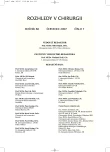Diagnosing Occult Pertrochanteric Fractures of Proximal Femur with MRI
Authors:
J. Bartoníček 1; J. Šprindrich 2; J. Skála-Rosenbaum 1; V. Frič 1
Authors‘ workplace:
Ortopedicko-traumatologická klinika 3. LF UK a FNKV, Praha-Vinohrady
přednosta: prof. MUDr. J. Bartoníček, DrSc.
; Radiologická klinika 3. LF UK a FNKV, Praha-Vinohrady, přednosta: doc. MUDr. J. Šprindrich, CSc.
2
Published in:
Rozhl. Chir., 2007, roč. 86, č. 7, s. 379-383.
Category:
Monothematic special - Original
Overview
A group of 9 patients with a suspected fracture of the hip underwent radiography and subsequently magnetic resonance imaging (MRI) diagnosis. Radiographic findings were in 2 cases negative and in 7 cases the radiographs revealed a fissure or fracture of the greater trochanter. MRI proved a complete pertrochanteric fracture in 1 case, an incomplete pertrochanteric fracture in 8 cases and in all the 9 cases a fracture of the greater trochanter. Occult pertrochanteric fractures were readily demonstrated with frontal scans. Sagittal and transversal scans showed only more precisely the course of the fracture line and involvement of the intertrochanteric crest, if any.
Among the 9 patients, 6 were managed conservatively and 3 patients were treated with a 2-hole DHS (dynamic hip screw). Indication for surgery was based primarily on the scope of the patients’ subjective complaints and on their general condition. All the 9 patients healed without complications.
The authors indicate MR imaging diagnosis in clinically suspected fractures of the proximal femur where the radiographic finding is negative. Fractures with a radiographic finding of a fissure or fracture of the greater trochanter should be examined by MRI that in most cases reveals an occult pertrochanteric fracture.
Key words:
pertrochanteric fractures – occult fractures – magnetic resonance – fractures of the greater trochanter
Sources
1. Alam, A., Willett, K., Ostlere, S. The MRI diagnosis and management of incomplete intertrochanteric fractures of the femur. J. Bone Joint Surg., 2005, roč. 87-B, s. 1253–1255.
2. Craig, J. G., Moed, B. R., Eyler, W. R., van Holsbeeck, M. Fractures of the greater trochanter: intertrochanteric extension shown by MR imaging. Skeletal Radiol., 2000, roč. 29, s. 572–576.
3. Deutsch, A. L., Mink, J. H., Waxman, A. D. Occult fractures of the proximal femur: MR Imaging. Radiology, 1989, roč. 170, s. 113–116.
4. Evans, P. D., Wilson, C., Lyons, K. Comparison of MRI with bone scanning for suspected hip fracture in elderly patients. J. Bone Joint Surg., 1994, roč. 76-B, s. 158–159.
5. Feldman, F., Staron, R. B. MRI of seemingly isolated greater trochanteric fractures. Am. J. Roentgenol., 2004, roč. 183, s. 323–329.
6. Gaunche, C. A., Kozin, S. H., Levy, A. S., Brody, L. A. The use of MRI in the diagnosis of occult hip fractures in the elderly: A preliminary review. Orthopedics, 1994, roč. 17, s. 327–330.
7. Haramati, N., Staron, R. B., Barax, Ch., Feldman, F. Magnetic resonance imaging of occult fractures of the proximal femur. Skeletal Radiol., 1994, roč. 23, s. 19–22.
8. Chana, R., Noorani, A., Ashwood, N., Chatterji, U., Healy, J., Baird, P. The role of MRI in the diagnosis of proximal femoral fractures in the elderly. Injury, 2006, roč. 37, s. 185–189.
9. Ingari, J. V., Smith, D. K., Aufdemorte, T. B., Yaszemski, M. J. Anatomic significance of magnetic resonance imaging findings in hip fracture. Clin. Orthop., 1996, č. 332, s. 209–214.
10. Kunešová, M., Koudela, K. jr., Koudela, K. sr., Koudelová, J. Vyšetření zlomenin horního konce femuru magnetickou rezonancí (MR) – přínos pro praxi. Acta Chir. Orthop. Traumatol. Čechoslov., 2006, roč. 73, s. 380–386.
11. Lang, P., Genant, H. K., Jergesen, H. E., Murray, W. R. Imaging of the hip joint. Computed tomography versus magnetic resonance imaging. Clin. Orthop., 1992, č. 274, s. 135–153.
12. Lubovsky, O., Liebergall, M., Mattan, Y., Weil, Y., Mosheiff, R. Early diagnosis of occult hip fractures MRI versus CT scan. Injury, 2005, roč. 36, s. 788–792.
13. Omura, T., Takahashi, M., Koide, Y., Ohishi, T., Yamanashi, A., Kushida, K., Inoue, T. Evaulation of isolated fractures of the greater trochanter with magnetic resonance imaging. Arch. Orthop. Trauma Surg., 2000, roč.120, s. 195–197.
14. Quinn, S. F., Mc Carthy, J. L. Prospective evaulation of patients with suspected hip fracture and indeterminate radiographs: use of T1-weighted MR images. Radiology, 1993, roč. 187, s.469-471.
15. Rizzo, P. F., Gould, E. S., Lyden, J. P., Asnis, S. E. Diagnosis of occult fractures about the hip. J. Bone Joint Surg., 1993, roč. 75-A, s. 395–401.
16. Roberts, C. S., Siegel, M. G., Mikhail, A., Botsford, J. Diagnosis: avulsion fracture of the greater trochanter. Skeletal Radiol., 1993, roč. 22, s. 236–238.
17. Schultz, E., Miller, T. T., Boruchov, S. D., Schmell, E. B., Toledano, B. Incomplete intertrochanteric fractures imaging features and clinical management. Radiology, 1999, roč. 211, s. 237–240.
18. Yao, L., Lee, J. K. Occult intraosseous fracture: Detection with MR Imaging. Radiology, 1988, roč. 167, s. 749–751.
Labels
Surgery Orthopaedics Trauma surgeryArticle was published in
Perspectives in Surgery

2007 Issue 7
Most read in this issue
- The “Pancreatic Unit“ in the Treatment of Severe Necrotizing Pancreatitis
- Surgical Management of Intrahepatic Cholelithiasis – Two Case Reviews
- Diagnosing Occult Pertrochanteric Fractures of Proximal Femur with MRI
- Stoma Procedures in the Cogenital Digestive Tract Malformations
